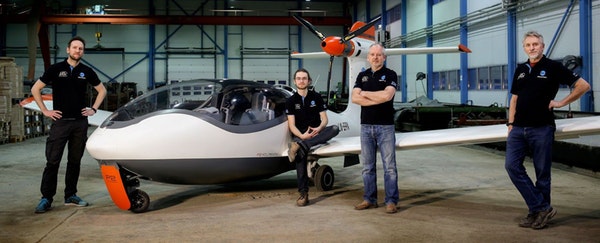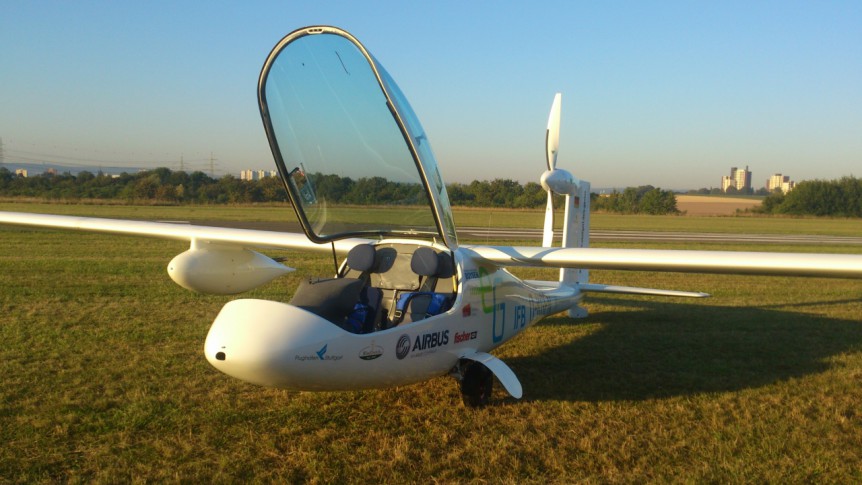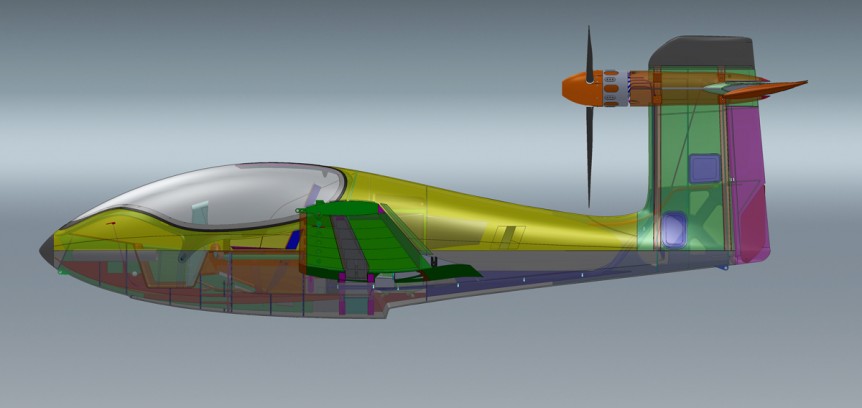The Culmination of Eight Years’ Effort Tomas Brødreskift, his father and a dedicated team of volunteers have been working on a nearly no-budget, eight-year project to build a cutting-edge technology hybrid amphibian aircraft. This past week, Equator P2’s wheels left the runway, twice on each of two days. The team plans a full flight around the airport traffic pattern in the next few days. Although brief, the runway runs demonstrated the hand control’s proper operation, similar to the hands-only controls used on human-powered aircraft. In that instance, the pilot’s legs are busy pedaling, obviating the need for manual operation only. In the Equator’s case, Tomas wanted simplified controls to make his aircraft a more desirable machine for future buyers. He is, after all, an industrial designer, creating beautiful things that would otherwise be mundane. He works with Classic Factory Automotive and Industrial Design, putting the “look” in exotic electric sports cars, bicycle frames, coffee makers, and designer watches, among objects. Crowd …
e-Genius Flies with a Range Extender
Stuttgart to Barcelona Dipl-Ing* Ingmar Geiß, Deputy Project Manager for e-Genius with the Institute of aeronautical engineering at Stuttgart University shared the news that e-Genius flew with its range extender for the first time on September 15. He notes that while the battery-powered airplane can manage trips up to 300 kilometers (186 miles), the hybrid engine/generator pod will enable flights up to 1,000 kilometers (620 miles). This would equal a trip from Stuttgart to Barcelona, Spain, according to the e-Genius web site. As the school explains, “With [the] e-Genius hybrid most flights of a typical user case can be done in the cost and energy efficient battery mode – for all longer flights the range extender can be used. Generator system control requires no pilot input, everything being done automatically. If the pilot wants to set down at the end of a trip with a certain amount of battery energy on board, e-Genius has an ingenious “look-ahead” feature to modulate …
Tomas Brødreskift to Appear at SA Symposium
With the upcoming Sustainable Aviation Symposium (May 6-7, 2016) already packed with stellar presenters, we are excited to have Tomas Brødreskift join the faculty. An industrial designer whose skills in product and process design, project management, ergonomics, and visual and CAD design have led and enabled him to bring his amphibious Equator P2 Xcursion to life will share his expertise and experiences with attendees at the Sofitel San Francisco Bay. Tomas’ demonstrated skills in designing everything from Hardrocx mountain bikes to an array of consumer goods have helped prepare him to guide the Xcursion from concept to final product. Since he has overseen every step of the design/build process, the airplane is a reflection of its unique specification and its designer’s attention to detail. The Equator web site explains, “The P2 was designed from the ground up to be a highly practical aircraft. It is made for 2 people initially (with a future option for 4 seats) with focus on …
SmartFlyer – an Electric Four-Seater?
The people behind the Smartflyer, a Swiss design concept now under development ask, “Why does the Smartflyer look like this? With a tail-mounted electric motor, it’s a bit reminiscent of e-Genius, and also a bit like a strutless Rutan Skigull. In fact, the basic configuration has been used on many significant aircraft over the last several decades, as a segment of Smartflyer’s web site shows. As Herr Professor Dipl-Ing. Rudolf Voit-Nitschmann, Project Leader on e-Genius explained, several benefits accrue from this arrangement of aerodynamic elements. Compared to a conventional touring motor glider a substantial larger propeller-diameter can be realized without a high and consequentially heavier undercarriage. Therefore the propeller-efficiency will increase. The front body part has the aerodynamic quality of a modern glider (no vorticities and local impact pressure peaks) and thus a very small drag. The propeller is optimally protected from ground contact. Electric motors are light enough to mount on a tail and are therefore able to benefit from that placement while …
EAS VIII: Pipistrel’s Certifiable Hybrid Aircraft
No hype, Pipistrel’s Hypstair (hipster) was introduced by Tine Tomazic and Gregor Veble at this year’s Electric Aircraft Symposium. The attempt to bring the world’s first certified hybrid aircraft to market is a joint venture by Pipistrel with partners Siemens, the University of Maribor, the University of Pisa and MB Vision, a specialist in providing visual information. Siemens, as might be imagined, is providing an “ultra-light weight integrated drive train” for the aircraft,” Slovenia’s University of Maribor the HIL (hardware in the loop) evaluation for electric motor control testing and dynamic emulation of mechanical loads, Italy’s University of Pisa for evaluation of hybrid technology advantages, and MB Vision for development and integration of the aircraft’s interior and human machine interfaces that will make the information presented to the pilot ideally selected and intuitively perceived. Far removed from the days when homebuilt aircraft advocates drew a chalk outline of the steel tubing they would weld together on the garage floor, the …
Eurosport Exploring New Configurations
Unhappily, we missed seeing Tom Leite at this year’s Electric Aircraft Symposium. Happily, he was at Eurosport Aircraft, his company in Portugal, working on innovative new approaches to making electric and hybrid motor-gliding a reality. He also has a speedster that would give those who desire rapid transit a high-style alternative. As shown in the video from Aero Friedrichshafen, the Crossover will probably trend toward a simpler wing configuration, with a fixed span of 18 meters (59 feet) and flaperons that will replace the multiple flaps on the current short-span version being flown in test flights. It’s uncertain whether the current twin-motors that pop out of the sides of the extremely slender fuselage will be retained, but a new version of the Crossover will feature three power options. As shown at Aero 2014, the airplane has the two options outlined on opposite sides of the fuselage – the port side displaying the Rotax-powered version, with a carbon-fiber shaft transmitting power …
A Different Kind of Hybrid
In the Innovation Pavilion at Oshkosh’s AirVenture 2013, Joseph Hutterer quietly drew people in with a model and an interesting approach to a single-fuel type of hybrid. Take the twin engines off the wings and place one of them in the modified tail. Now put a small turbojet in a retracting pod in the nose. Taxi out to the end of the runway and use both engines to take off and climb, then shut the nose jet down, retract that, and cruise on the single rear engine. Hutterer, with an Aeronautical Engineering degree from the University of Minnesota, FAA commercial pilot’s license with single-engine, multi-engine, instrument and glider ratings, and 42 years of engineering and marketing experience in the general aviation industry, has the credentials and the patents to make his approach credible. Consider that aircraft such as the Solar Impulse cruise on only about 10-percent of what they need for takeoff and climb. A typical business twin doesn’t have …
EADS’ Electrifying Threesome at Paris Air Show
EADS (European Aerospace Defense Systems), known colloquially as Airbus, highlighted its Paris Air Show chalet at Le Bourget with three examples of the work from its Innovations Workshops. All projects are part of the European Commission’s “Flightpath 2050” initiative, conceived to reduce carbon dioxide (CO2) emissions 75 percent, nitrogen oxide (NOx) emissions 90 percent and noise 65 percent from 2000 levels by 2050. EADS thinks electric and hybrid propulsion could become an alternative to fossil fuels within that timeline, with several projects highlighting, “the willingness of EADS to invest in technologies that today, tomorrow, will further reduce emissions of carbon dioxide from aviation.” E-FAN Working with Aero Composites Saintonge (ACS), the IW Research and Technology Group has developed and built the trainer all-electric “E-Fan” dedicated to general aviation. Created in only eight months, this jet-like machine makes use of sailplane design and ultralight-type composite construction to house its two electric motors and two 65-kilogram battery packs in its wings. Motors appear …
Randall Fishman’s ElectraFlyer ULS – a Gateway Plane
Appearing before attendees at the 2013 Electric Aircraft Symposium, Randall Fishman’s spoke of great accomplishments and grander visions. “ElectraFlyer ULS & Electric Ultralight Airplanes, the path to approval for all electric aircraft?” showed ElectraFlyer’s history and the ambitions Randall would like to play out. A pioneer in ultralights, Randall has been flying hang gliders since 1972, produced the first continuously powered electric aircraft, flew the first electric airplane at Oshkosh’s AirVenture and claims a primary interest of bringing practical, user-friendly electric flight to as many people as possible. Between 2005 and 2007, he designed, built and test flew his first electrically-powered trike. Making its first take-off on April 29, 2007, by May 2 it had made a one-hour flight. Ever more venturesome, Randall modified a Moni motorglider with an electric motor and flew that at AirVenture in 2008, for which he won both the Stan Dzik Memorial Award for innovation and the Dr. August Raspet Memorial Award for “outstanding contribution to …
Eurosport Crossover Sports Many Tricks
We’re used to seeing motorgliders which pop an engine or motor up on a tall stalk behind the cockpit, then retract it into the slim tailboom for minimum drag. Why not do the same with two electric motors on each side of the airplane, tucking them in a slender fuselage for soaring? Emails with Eurosport’s Tom Leite and perusal of the Portuguese firm’s web site and on-line brochure verified that almost everything on the Crossover motorglider is electric and retractable. Tom notes, for instance, “Our motor/props fold into the fuselage: [they are] 3-phase PMSM motors up to 40Kw at takeoff each.” In the video, see the long, spar web-like structure with lightening holes that separates the two motors as they slide into and out of the fuselage. “Our wing span is set from 9.6 to 15 meters and is electrically operated.” Tom refers to the special version that will have extendable and retractable wings, with tip segments sliding out from …
- Page 1 of 2
- 1
- 2



